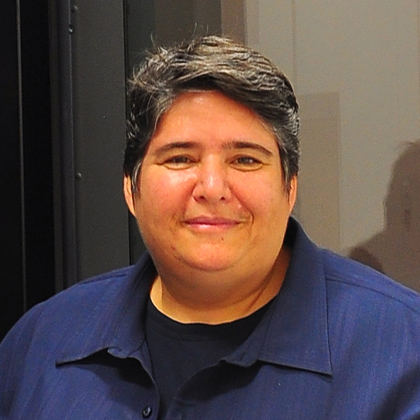Nicastro selected for Pew Innovation Fund award to study herpesviruses

UTSW structural cell biologist Dr. Daniela Nicastro has been selected to join the Pew Charitable Trusts’ 2020 class of Innovation Fund investigators to launch a joint research project on the assembly and trafficking of herpesviruses inside infected cells. She and Dr. Ekaterina Heldwein, Professor of Molecular Biology and Microbiology at Tufts University School of Medicine, are one of six pairs of investigators who make up this year’s class.
“This is exciting because it will jump-start a collaborative project that each of our labs individually would not have been able to pursue,” said Dr. Nicastro, Professor of Cell Biology and a Cancer Prevention and Research Institute of Texas (CPRIT) Scholar. “Members of the Heldwein lab are experts on virus research – a timely topic – and my lab has the necessary expertise and instruments to image cellular processes happening deep inside virus-infected host cells with molecular resolution.”
Cell membranes are stable and selectively permeable barriers that protect cells from their environment or form cellular compartments (organelles) with specialized environments to serve different functions. For most viruses to successfully complete their life cycle – enter the host, replicate, assemble, and exit the host – they have to cross multiple membrane barriers, such as the plasma membranes and internal membranes. The herpesviruses pass through the two membranes of the nuclear envelope in a unique manner, which could offer insight for therapeutic targets. The researchers hope to provide a better understanding of the structures and mechanisms involved in this essential step in the viral life cycle to ultimately prevent or cure herpesvirus infections.
“We will establish approaches that are not yet routine, share our technical knowledge with the Heldwein lab, and visualize details of virus infections not previously seen,” Dr. Nicastro said. “The nuclear egress – or escape – from herpesviruses is unique and a potential target for therapy.”
Launched in 2017, the Pew Innovation Fund encourages collaborative projects among Pew’s existing biomedical network of over 1,000 scientists and researchers from the United States and Latin America. The award provides $100,000 per year for two years, which the two labs will split.
Dr. Nicastro’s work was also recently honored with the 2020 WICB Mid-Career Award for Excellence in Research by the American Society for Cell Biology.
Born and raised in Germany, Dr. Nicastro received her Ph.D. in biology from the Ludwig-Maximilians University in Munich and worked at the Max-Planck Institute for Biochemistry. She came to the U.S. as a postdoctoral fellow at the National Center for Research Resources for 3D Electron Microscopy of Cells at the University of Colorado in Boulder before joining the faculty at Brandeis University, where she also directed a small cryo-EM facility. She was recruited to UT Southwestern in 2015 to build a state-of-the-art cryo-electron microscopy facility.
Dr. Nicastro and Dr. Heldwein first met as members of the Class of 2007 Pew Biomedical Scholars. They previously collaborated on a paper published in Nature Communications in 2014, when Dr. Nicastro was still at Brandeis.
UTSW Professor of Microbiology Dr. Julie Pfeiffer – also a 2007 Pew Biomedical Scholar – was among the Pew Charitable Trusts’ 2019 class of Innovation Fund investigators.
Dr. Pfeiffer holds the Kern and Marnie Wildenthal President’s Research Council Professorship in Medical Science.

